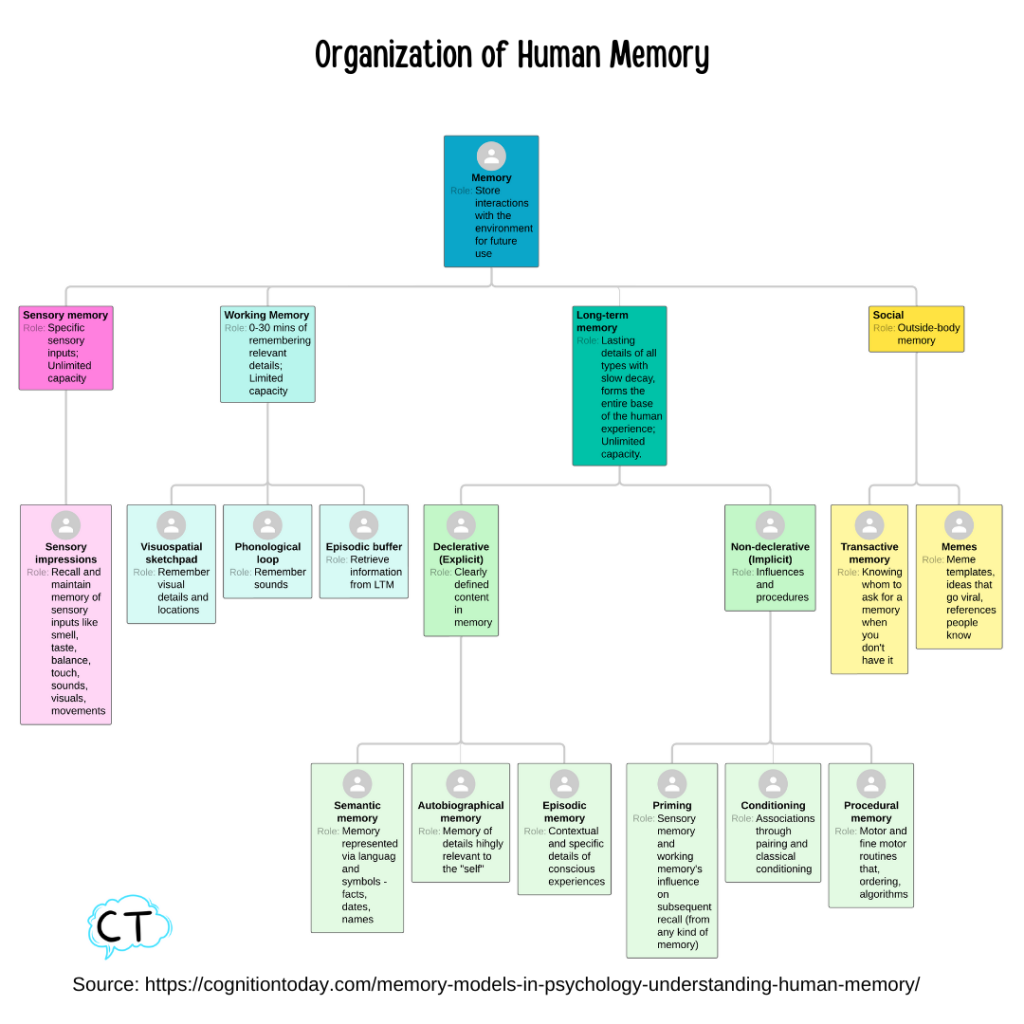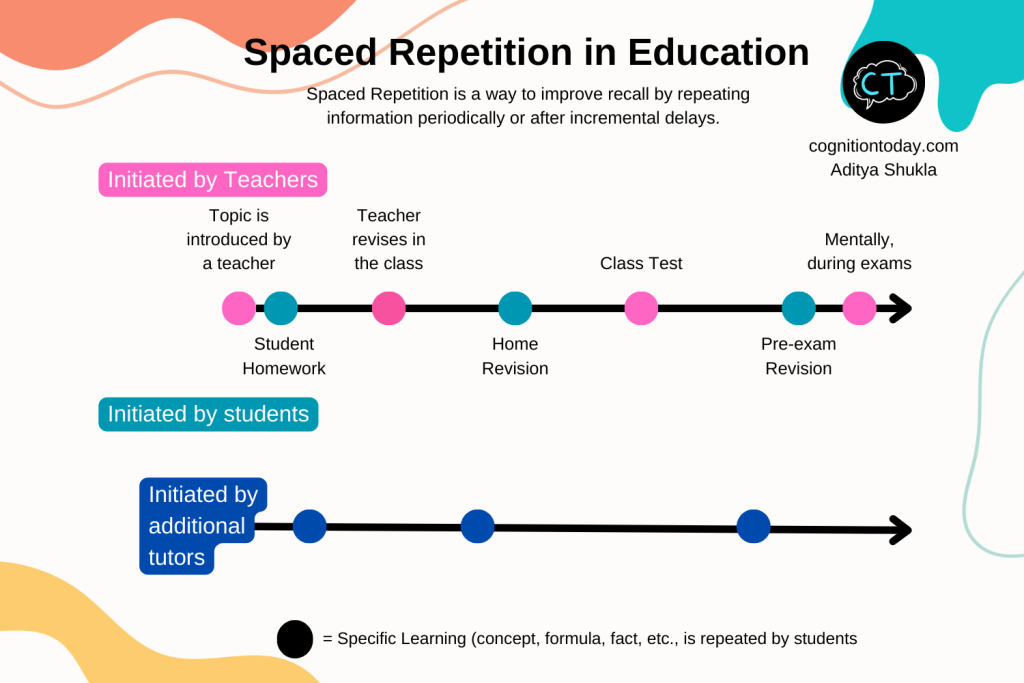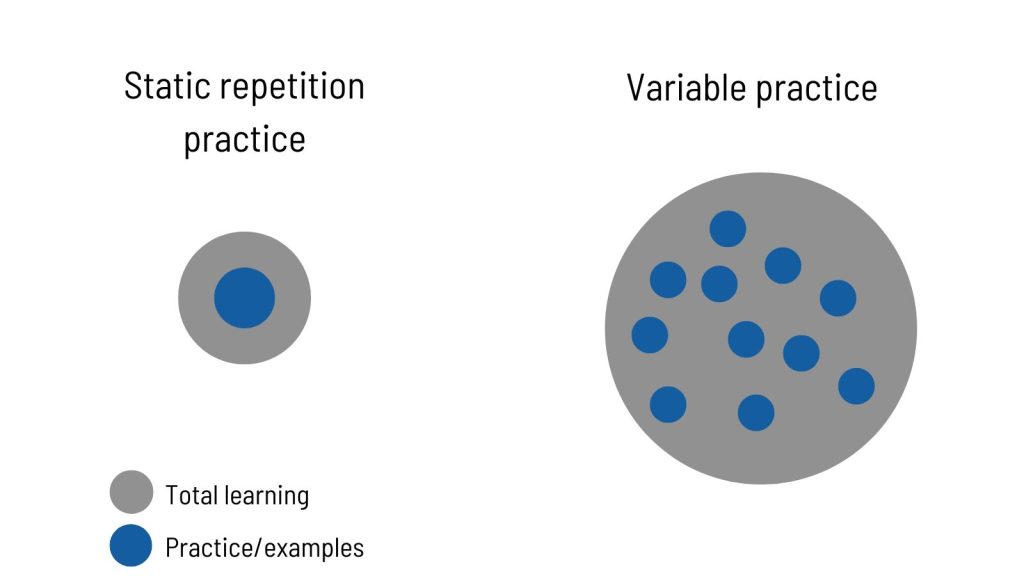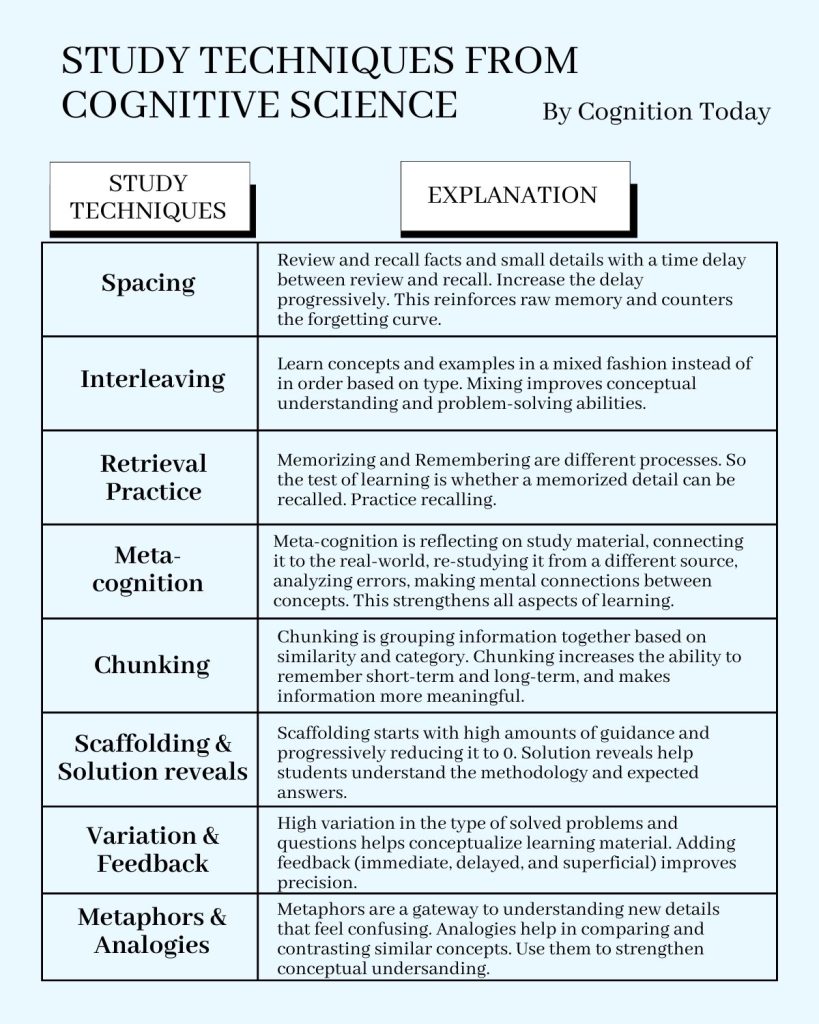From a theoretical POV, our memory is the base component of measurable learning. Read on to explore learning and memory in an educational context. This article is restricted to just the cognition bit and not the fun social & emotional aspects to limit the information density.
We use the idea of learning in 2 ways in conversation.
Learning (process verb): It is the acquisition of any of these types of memories and proving those memories exist.
E.g., I am learning how to play the guitar (which means I am acquiring memory units through some process and want to prove that I have acquired them by playing).
Learning (noun): It refers to memory but in the context of proving that the learning process has occurred.
E.g., my leaernings during medical training have helped me a lot.
In everyday conversation, memory and both types of learning are used interchangeably, but from an educational context, there are many nuances.
The organization of human memory
When you look at different forms of memory, you can see there are a lot more nuances than the basic framework of recognizing something (knowing it’s in your memory) and recalling (being able to reproduce information).

Memory Role: Store interactions with the environment for future use
- Sensory memory Role: Specific sensory inputs; Unlimited capacity
- Sensory Impressions Role: Recall and maintain memory of sensory inputs like smell, taste, balance, touch, sounds, visuals, movements
- Working Memory Role: 0-30 mins of remembering relevant details; Limited capacity
- Visuospatial sketchpad Role: Remember visual details and locations
- Phonological loop Role: Remember sounds
- Episodic buffer Role: Retrieve information from LTM
- Long-term memory Role: Lasting details of all types with slow decay, forms the entire base of the human experience; Unlimited capacity
- Declarative (Explicit) Role: Clearly defined content in memory
- Semantic memory Role: Memory represented via language and symbols – facts, dates, names
- Autobiographical memory Role: Memory of details highly relevant to the “self”
- Episodic memory Role: Contextual and specific details of conscious experiences
- Non-declarative (Implicit) Role: Influences actions and procedures
- Priming Role: Sensory memory’s influence on working memory’s influence on subsequent recall (form any kind of memory)
- Conditioning Role: Associations through pairing and classical conditioning
- Procedural memory Role: Motor and fine motor routines that, ordering, algorithms, using formulas and scientific procedures.
- Declarative (Explicit) Role: Clearly defined content in memory
- Social Role: Outside-body memory
- Transactive memory Role: Knowing whom to ask for a memory when you don’t have it
- Memes Role: Meme templates, ideas that go viral, references people know
This entire content of memory is stored as network of 2 types of data. First, it’s the unit of memory itself – it contains the images, numbers, objects, concepts, etc. And second, it’s the connectivity and associations between multiple units of data – it contains the contexts, relationships between concepts, procedures, sequences, etc.
From the computer science perspective, the data is stored as a “Graph”.
Unconscious vs. Conscious processes in memory
Working memory is most consciously managed. Everyday life and paying attention depends on it. Attention is just utilizing the brain’s default system of prioritizing information and storing it in working-memory. Active thinking and processing in a classroom is all about what stays in the working memory, which has rough capacity of 4 items[1] for 30 seconds to 30 minutes.
A very unique property of our working memory is that we can compress items in it to fit more. Just like a zip file compresses files on a computer using patterns in data, humans compress information by finding patterns in it[2]. Chunking is the most common way to compress this data. E.g., a person can remember 20 grocery items if they group (chunk) them together, but recalling a list of 20 items in order will be very difficult. Students are particularly in the phase of chunking information as they try to fit what they learn into what they already know. E.g., new vocabulary is chunked based on similarity and related known words, formulas are chunked by what they do (like surface area, volume, quadratic expansions, etc.). When students fail to recall correctly, there is a high chance that they compressed the information wrongly. That is, they find the wrong pattern in new learning that creates confusion.
Metaphors and analogies are another way to compress information, and confusion is equally likely if the analogies aren’t strong.
This compression then promotes their learning into long-term memory.
Long-term memory is actively engaged during recall, or when you are purposefully learning something to make it enter long-term memory. When students learn something again, related to what they know, their long-term memory is re-activated[3] to support and expand working memory.
The short-term memory is actually a very short-term memory – 10-20 seconds. This memory is strongly coupled with attention. It’s primary use is to maintain focus and relevance with what just happened. For example, your short-term memory will automatically register the words here for about a paragraph so you understand what is happening. This is fully automatic. The working memory concept is a bridge between short-term and long-term memory with the addition of an active processing components. It let’s information in the short-term memory and from the long-term memory combine for active thinking. This lasts upto 30 minutes.
Sensory memory is not meaningfully accessible beyond detecting sensations (like remembering a smell from years ago).
Procedural memory – really underrated – but it is consciously engaged (cooking), but it also becomes a habit and unconscious (movement of drinking water). Students acquire this from practice and repetition. Self-reflection strengthens it too.
Long-term memory’s declarative (explicit) memory is pretty much under conscious control and most of our specific knowledge rests in that. Students acquire this form mostly through homework, classwork, self-reflection, and exams.
Priming & conditioning are the least under our everyday control, and have unconscious influences. Students acquire this form of memory by just being present in different environments. This can be controlled to a degree by parents, schools, teachers, but it is mostly outside the student’s control.
Memes & Transactive memory is purposefully engaged every day because we make references and go to specific people to ask them what they know. Students will acquire this through social engagement, fun, play-time, and being on the internet.
Meta-memory
Apart from memory, which is the actual unit of knowledge, the brain has a secondary process called the meta-memory system. This system is a layer on top of memory and influences a student’s confidence and trust in their own memory.
Metamemory – Knowledge about the properties, details, functioning, and capacity of one’s own memory. The simplest form of metamemory is knowing you have a memory without remembering the details. If you’ve ever experienced the tip-of-the-tongue phenomena (you can’t recall a memory but know you have it, like a movie’s name), you’ve concluded you have a memory via your metamemory, not actual memory. From a computer programming point of view, it’s knowing there is (or isn’t) an item in a database without actually looking it up, like looking at only the key or value in a pair. Metamemory is also similar to a file’s meta-data on the internet.
All humans have the capacity to quickly figure out[4] what they know and don’t know, and their judgments are quite accurate. For example, without searching the entire mind for all memory units, we can easily tell if we know the answer to a question in an exam. We can look at the question paper and quickly assess what we know without going through the details of what we know. This may seem paradoxical at first, but it isn’t – how can we know what’s in a drawer without checking it? Humans have multiple representations for memory that indicate whether a memory exists or not and to what extent. For example, artificially triggering[5] a small set of neurons that are attached to a memory can activate a larger network of neurons that hold that memory.
Metamemory has 8 unique[6]types of details about memory:
- Strategy: Knowledge of memory techniques and tricks to aid memory. This would prompt you to use a strategy or learn a strategy for specific goals like studying, such as mnemonics to learn biology. E.g., Students say “I before E except after C and weird is just weird” as a mnemonic.
- Task: Knowledge that a task demands memory and recalling ability vs. familiarity or on-the-go analysis. This would prompt you to know how you can do a task if it needs memory or analysis or both. E.g., Student says, “This will take some memorizing, I’ll do it later.”
- Capacity: Knowledge about one’s overall/general memory capacity. This would reflect an accurate understanding of what you are good at remembering, what you are bad at, and where you have gaps in memory. E.g., Student says, “Ma’am this is too easy, I’ll remember this.”
- Change: Knowledge about how one’s memory changes over time or in different circumstances. This would reflect an accurate understanding of what you could remember well as a child, or what you got good at as an adult, and how that has changed over time. E.g., Student says, “Teacher if we study this before the exam, we’ll remember”
- Anxiety: Knowledge about how anxiety (and stress) affect memory performance. This would prompt you to pass judgments about how you might not remember something important during an interview because of nervousness, and then you may decide to focus more on those details that are prone to slip your mind during stress. E.g., Student says, “Ma’am I learned everything but during exam I forget.”
- Activities: Knowledge of what activities support memory. This would prompt self-reflection about how your memory might be affected by lack of sleep or diet. E.g., Teacher says, “Sleep well before exam so you don’t forget.”
- Achievement motivation: The motivation and intention to maximize memory potential. This would reflect the motivation and confidence to perform memory tasks better when taken seriously vs. casually. E.g., Student says, “Sir, i want to qualify, I’ll be able to learn all of this.”
- Locus: Knowledge about how much control one has over their memory (little control vs. high control): This would contain beliefs about how well you can improve your memory or how easily you can lose it with your own actions (such as drinking or no exercise) vs. how easily you believe genetics play a role or you can’t change your memory abilities beyond a small limit. E.g., Student says, “Teacher I can remember this now, but I won’t remember it next year.”
Common factor of learning and memory
Memory is considered to be a stable change in neurons. The junctions between neurons behave a specific way. For example, once a student learns a math formula like (a + b)(a – b) = a2 – b2, certain neural patterns are fired in a stable way representing that formula. The same will go for a longer physical movement in sports/dance or finer concepts like “a dog” or “a forest”. The memory is stored as components after neurons handling those components become stable. This stability is acquired through multiple biological processes that are called neuroplasticity.
- Neurons myelinate – a fatty deposit forms over the axon of a neuron. This improves electrochemical transmission across those neurons.
- Synaptic strength – in a process called long-term potentiation, when one neuron repeatedly stimulates another neuron, the synapse (connection gap between the 2) gets more receivers to capture the signal. This enhanced capturing means more signal strength between 2 neurons.
- New neurons are used to accommodate new learning – the hippocampus of the brain (and other regions to a smaller degree), produces new neurons every day – at least 700. These are either utilized for something new a student learns or discarded as waste products if the student doesn’t learn.
- Axon connectivity – the transmission cable of the brain is the axon, which takes a signal from the cell body of a neuron, carries it across a synapse, and connects to the dendrite of another neuron, which then sends the signal back to another axon. This connectivity creates a brain circuit that specializes in a larger body of new things students learn – like a language skill, a mental arithmetic skill, etc.
From the point of view of biology, learning and memory are the same. Memory becomes the existence of these neurobiological changes, and learning becomes the process through which they come into existence. The difference lies in what aspect you are looking at.
If the neurons are actively undergoing a change, they are in a process of learning, or more specifically, memory consolidation. Learning is more of an observable process. That process is education itself as a whole and its basic components like feedback, homework, practice, conversations, rehearsals, activities, exams, etc. Memory is more of a proof that learning has occured.
The Forgetting curve
The forgetting curve is a natural tendency for most memorized information to lose its neural stability and decay. It was first formalized by Hermann Ebbinghaus, a pioneering psychologist from Germany who studied human memory. He discovered[7] that a memory will tend to fade over time (forgetting), and reinforcing it periodically will strengthen it and reduce that decay (the spacing effect). The strength of the memory and its rate of decay depends on the strength of neural connections that represent a memory. The more it is rehearsed over time, the stronger it becomes. If you rehearse once and leave it be, the decay starts, and eventually, you forget. Stabilizing the neural pathways that represent memory is called learning and that happens via neuroplasticity – changes in how neurons connect to each other.

The spacing effect is the most common way to counter the forgetting curve. The spacing effect says that a unit of memory gets stronger if it is repeated or re-inforced (via recall) over increasing periods of time. From the education point of view, this means period revision counters forgetting. From the learning point of view, this technique is called Spaced repetition.
A simple timeline of spaced repetition in the classroom will look like:

Random instances of recalling also strengthen memory, but spacing them with increasing delays is more strategic.
After adding the memory’s associations and related concepts into this mix, the whole knowledge base a student has to acquire gets stronger with time.
Variable learning
There is a whole theory about adding variations into this process which I’ve discussed in depth here – the main observation in psychology is that variation about a single concept or skill tends to make that learning more robust and flexible across different contexts.
E.g., running on different terrains instead of just running on a treadmill will make you a better runner. Or learning about chemical elements in the context of different everyday substances will enhance memory & understanding for the core properties of these elements. But the learning mechanism here is – variation about a concept/skill enhances learning and that learning’s application.

Basic principles of learning
To limit the size of the post, check out the linked articles for more description!
- Conditioning – All about repeatedly associating concepts & ideas together.
- Instrumental conditioning – All about rewarding good behavior (positive reinforcement) and showing consequences of bad behavior (punishment).
- Observational learning – All about showing and demonstrating how things are done so students can emulate/copy and remember.
- Metacognition – All about linking old knowledge to new knowledge and thinking about it.
- Scaffolding – All about helping students learn how things are done with help and then gradually removing that help.
- Repetition – All about purely repeating information to strengthen memory.
- Variation – All about learning a concept through multiple examples, approaches, and contexts. Also helps to foster curiosity.
- Metaphors and Analogies – All about making a new educational material and comparing it to something students already understand.
- Context & Concepts – All about defining the boundaries & properties of a concept, it’s context, and when the boundaries get blurry.
- Competency & Skill – All about finding proof of learning through worked-out problems, tests, demonstrations, applying in the real world, and creative problem-solving.
These core learning principles will typically enhance any and all students’ learning outcomes in some capacity.
And some specific quick-use techniques, follow the chart below 🙂

Sources
[2]: https://psycnet.apa.org/record/2024-22356-001
[3]: https://www.jneurosci.org/content/28/35/8765.short
[4]: https://www.sciencedirect.com/science/article/abs/pii/S0079742108600535
[5]: https://www.nature.com/articles/nn.3592
[6]: https://academic.oup.com/geronj/article-abstract/38/6/682/586706
[7]: https://www.jstor.org/stable/1413271

Hey! Thank you for reading; hope you enjoyed the article. I run Cognition Today to capture some of the most fascinating mechanisms that guide our lives. My content here is referenced and featured in NY Times, Forbes, CNET, and Entrepreneur, and many other books & research papers.
I’m am a psychology SME consultant in EdTech with a focus on AI cognition and Behavioral Engineering. I’m affiliated to myelin, an EdTech company in India as well.
I’ve studied at NIMHANS Bangalore (positive psychology), Savitribai Phule Pune University (clinical psychology), Fergusson College (BA psych), and affiliated with IIM Ahmedabad (marketing psychology). I’m currently studying Korean at Seoul National University.
I’m based in Pune, India but living in Seoul, S. Korea. Love Sci-fi, horror media; Love rock, metal, synthwave, and K-pop music; can’t whistle; can play 2 guitars at a time.



























